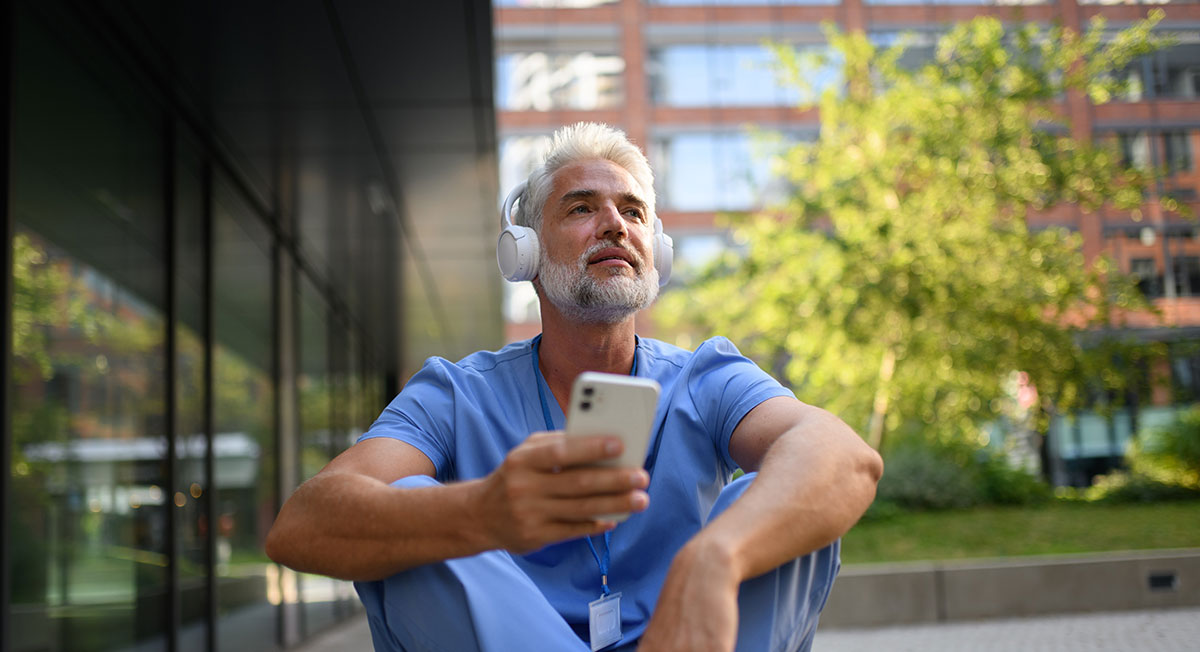A Quiet Practice in a Loud Profession
Medicine is loud. The beeping monitors, the nonstop pages, the clinical chatter, the emotional highs and lows—they create a constant current of noise. It’s easy to get swept up in that current, to move so fast that you lose your bearings. I know because I’ve been there.
Over the years, working as a hospitalist in places like Frankford Hospital, Main Line Health, and now Penn Medicine, I’ve experienced firsthand the physical and emotional toll this profession can take. I’ve also seen how that toll quietly builds: the skipped meals, the short fuses, the sleepless nights. You don’t realize how far off-center you’ve drifted until something—an error, an illness, or an overwhelming day—forces you to pause.
That’s where meditation came in for me. It didn’t solve everything overnight, but it gave me a tool I didn’t know I needed: the ability to stop, breathe, and listen—not just to others, but to myself.
Burnout: The Hidden Epidemic in Healthcare
Burnout isn’t a personal weakness. It’s a predictable outcome of a system that demands perfection, speed, and emotional resilience at all times. The World Health Organization defines burnout as a syndrome caused by chronic workplace stress that hasn’t been successfully managed. In medicine, we see this daily.
Colleagues feel emotionally drained. Residents question their career choice. Patients sometimes receive care from clinicians running on empty. The impact goes beyond the physician’s well-being—it affects patient outcomes, staff morale, and even hospital culture.
We spend our days diagnosing others, but often ignore the warning signs in ourselves. That needs to change.
What Is Mindfulness—and Why Does It Matter?
Mindfulness is the practice of being present, aware, and nonjudgmental in the current moment. It sounds simple—and in many ways it is—but it’s also incredibly powerful.
When I started meditating, it was just five minutes at the beginning of the day. I sat quietly, focused on my breath, and tried to stay with it. My mind wandered constantly. But I kept practicing. And over time, I noticed a difference—not just during meditation, but during rounds, in tough conversations, and in the moments between tasks when I might otherwise have reacted without thinking.
Mindfulness helps doctors stay grounded. It improves focus, emotional regulation, and resilience. It allows us to respond thoughtfully rather than react impulsively. And in a profession where one decision can change a life, that kind of clarity is essential.
How Meditation Improves Patient Care
It might seem like a stretch to connect meditation with better medical outcomes—but it’s not. Studies have shown that mindful physicians communicate more effectively, listen more deeply, and make fewer errors. When we’re present with patients, they feel it. They trust more. They share more. And that trust leads to more accurate diagnoses and better adherence to treatment plans.
Mindfulness also improves our ability to tolerate uncertainty. Every physician knows the discomfort of not having a clear answer. But instead of rushing to order tests or making snap judgments, a mindful approach encourages us to pause, reflect, and acknowledge complexity. That kind of pause can lead to better decision-making and less unnecessary intervention.
Patients want to feel heard. They want to feel like their doctor sees them as a person, not just a diagnosis. Practicing mindfulness helps us offer that presence.
Starting Small: Meditation for Busy Doctors
One of the biggest barriers I hear from colleagues is time. “I’d love to meditate, but I don’t have 30 minutes a day.” The good news is—you don’t need 30 minutes. You just need intention.
Here are a few simple ways I’ve integrated mindfulness into my daily routine:
- One-minute breath break between patients. Eyes closed, phone away. Just breathe.
- Mindful walking down the hallway—feeling each step instead of mentally racing ahead.
- A three-minute pause before or after a difficult conversation.
- Gratitude check-in at the end of the day: What went well today? What am I learning?
If you can give a patient your full attention for 15 minutes, you can give yourself three. It’s not indulgent—it’s necessary.
Teaching Mindfulness in Medical Education
As an educator, I’ve had the privilege of mentoring many residents over the years. I’ve received teaching awards like the D. Stratton Woodruff Award and the 2022 Faculty Award for Resident Teaching—but I see those recognitions not as achievements, but as opportunities.
One of the most valuable things I can teach young physicians is how to care for themselves. That means creating space for reflection, vulnerability, and mental wellness. We need to normalize mindfulness in medicine—not as a luxury, but as a core clinical skill.
I often invite students and residents to join me in short meditations before rounds or to reflect silently before case discussions. These practices build emotional intelligence and help them become not just smarter doctors, but better humans.
Coming Back to Center
Meditation won’t make your inbox disappear. It won’t cure the flaws in our healthcare system. But it will change how you show up within that system. It will help you stay connected to your purpose, even on the hardest days. It will remind you that you’re not just a provider—you’re a person. And your well-being matters.
Burnout thrives in silence. But mindfulness creates space for awareness, connection, and healing. In that space, we find the clarity to keep going—not just for our patients, but for ourselves.
So if you’re feeling overwhelmed, I encourage you to pause—just for a moment. Close your eyes. Take a breath. Start there.
